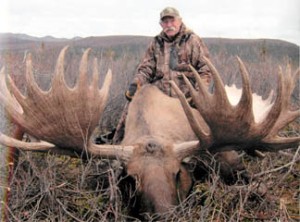
Photos by Jenny Neyman, Redoubt Reporter. A Kenai Peninsula hunter testifies Friday to the Alaska Board of Game during its Southcentral Region meeting held Friday through Tuesday in Kenai.
The Alaska Board of Game worked its way through the Kenai Peninsula portion of its agenda Tuesday, liberalizing hunting and trapping opportunities on moose, wolves and bears.
The following are measures regarding moose adopted at Tuesday’s meeting:
- Proposal 143 — Modify the bag limit for moose to one bull per year with an antler spread of 50 inches or greater, or a spike or four brow tines on one side in Game Management Units 7 and 15. The season will stay the same — Aug. 10 to 17 for bow hunting and Aug. 20 to Sept. 20 for the general hunt. The requirement that antlers be sealed by a department representative within 10 days also is retained, except in the Placer River/Placer Creek permit hunt, which is open to retention of any bulls. The proposal also adds a definition of a spike as “antlers of a bull moose with only one tine on at least one side; male calves are not spike bulls.”
- Proposal 147 was adopted, lowering the intensive management population objective for moose in Unit 15A from a range of 3,000 to 3,500 to a range of 2,000 to 2,900, and lowering the intensive management harvest objective for moose in 15A from a range of 180 to 350 to a range of 120 to 290. The proposal retains Fish and Game’s ability to conduct aerial shooting of wolves in Units 15A and 15C as a measure of predator control to benefit moose populations, although this has not been implemented since the board first OK’d aerial wolf kills at its meeting in 2011. This proposal also approves allowing Fish and Game to employ or contract with trappers to target wolves and increase their harvest within the established wolf-trapping season and related regulations, as another measure of predator control.
- Proposal 148 reauthorizes the antlerless moose season in a portion of Unit 15C — the roughly 100-square-mile bench area around Homer.
- Proposal 150 failed. It would have allowed the use of motorized vehicles to retrieve harvested moose meat during certain hours — 10 a.m. to 3 p.m. and during the “dark of night” — in the Lower Kenai Controlled Use Area.
- Proposal 151 failed. It would have reinstituted a closure of the Palmer Creek/Lower Resurrection Creek areas in Unit 7 to moose hunting. The area, near Hope, will remain open to moose hunting.
By Jenny Neyman
Redoubt Reporter
Thirty years ago, moose on the Kenai Peninsula were legendary for their size and abundance. Now, however, it appears increasingly likely that those historic days are, indeed, history, as land and wildlife managers wrestle with measures to boost the dwindled ungulate population.
In the halcyon days, the peninsula’s moose population was estimated at around 4,000. Nowadays, it’s far less than that. A recent census, conducted just a few weeks ago by the Alaska Department of Fish and Game, estimates 1,600 moose in Game Management Unit 15A, covering 1,300 square miles of the northwestern Kenai Peninsula. That’s down from about 2,000 in 2008, and that, in turn, is about 40 percent less than census estimates in the 1990s. Just four moose were harvested by hunters in 15A last year, and just four the previous year, down from the once-typical 350 to 360 a year. That’s in part due to the smaller population, and in part due to decreased hunter participation after the Alaska Board of Game enacted stepped-up hunting restrictions in 2011 to protect the population.
The Board of Game met in Kenai from Friday through Tuesday to consider proposals covering Game Management Units in Southeast, Cordova, Kodiak, the Anchorage area and the Kenai Peninsula. Nine proposals were submitted regarding moose on the peninsula, aimed at finding a balance between bolstering the population with the hope of increasing hunter opportunity.
The proposed changes are largely incremental — measured tweaks to conditions and regulations, which, if results come as intended, would effect incremental changes to the population. But the biggest contributing factor to the decline in moose population is far more substantial, than incremental, in scale.
Moose are not werewolves, yet there is believed to be a silver-bullet solution to the most significant problem of their decline. What’s needed, say land and wildlife managers, is fire, but not just any fire. This would be the Goldilocks of wildland fire — hot enough to burn down to mineral soil but not too hot so as to burn out of control, widespread enough to regenerate tens of thousands of acres of forest that has matured beyond the point of providing good moose browse, yet not so big that it poses too big a threat to human health, habitation, development and transportation, and occurring under just the right conditions and timing so as to not overtax available firefighting resources.
That solution is proving to be as mythical as werewolves.
“The Kenai has had harvest well in excess of 1,200 moose alone, historically, and you’re going to hear from a lot of folks who have been here a long time and remember the good old days and want those days back,” said Ted Spraker, chair of the Board of Game and retired Kenai-area Fish and Game wildlife biologist, in starting off the meeting Friday.
















